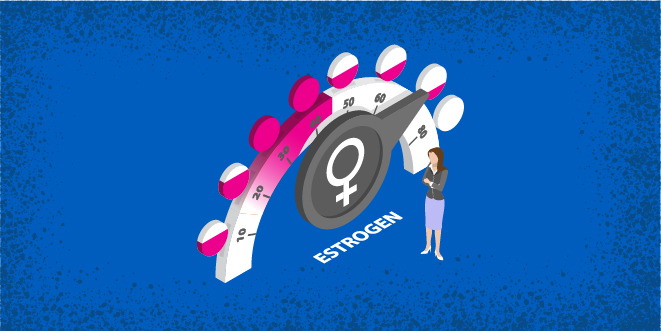Coping with Hormonal Ups and Downs

In a world that is seemingly so advanced in some areas, is still sincerely lacking in others.
Take the menstrual cycle, for example. This natural and normal process that takes place in around 50 percent of the population is still a taboo and seen as “unclean” in many parts of the world.
And because of these negative connotations, there’s a huge lack of research on important topics such as physiological and behavioral issues in the realm of the menstrual cycle.
So today, we aim to talk about these issues and possible solutions to help you feel your best, starting with hormonal changes throughout your cycle.
Hormonal changes across the four phases of the menstrual cycle
Each of the four phases of the menstrual cycle are accompanied with hormonal changes. And with hormonal changes come a slew of different behaviors and physiological effects.
Here is a nifty summary of hormonal changes during the menstrual cycle:
- During menstruation there’s a drop in both estrogen and progesterone and a rise in the follicle-stimulating hormone (FSH).
- In the first half of the menstrual cycle (follicular phase) there is a steady rise of estrogen.
- When estrogen peaks, the luteinizing hormone (LH) triggers ovulation. Then there is a rise in progesterone until menstruation begins.
- During the second half of the menstrual cycle, the luteal phase sees yet another rise in estrogen.
- Just before menstruation begins, there’s a decline in progesterone.
We know that all sounds quite technical and possibly hard to understand.
The big takeaway here is that there is indeed a rise and fall of a number of different hormones across the menstrual cycle which has a direct influence on behavior, mood, and functioning.
Here are a few tips that may help you to deal with those ups and downs…
How to be more comfortable during the hormonal changes of your menstrual cycle
During menstruation
How you may feel during menstruation (days 1-5) when estrogen and progesterone drop and there’s a rise in follicle-stimulating hormone (FSH)
During your period, the most common symptoms are:
How to feel more comfortable:
To soothe those tummy and lower back cramps, you can apply heat to the area (for example, using a hot water bottle). When you do this, it will help relax the muscles and aid in less pain. Additionally, taking an OTC pain reliever for your cramps and possible headaches is an option.
Another option is to orgasm. This is because, when we orgasm, the hormone endorphins are released. These are the body’s natural pain killer.
As per bloating, if you focus on the types of food you’re eating and engage in exercise, it could make a big difference. Try to drink lots of water, skip caffeine and alcohol, limit processed food, and engage in some form of exercise.
To help minimize fatigue, you could try to regulate your sleeping. Sleeping too much can actually make you feel more tired. You could also exercise as it’s been proven that physical activity boosts energy levels (yoga is also a great idea), and/or you could take omega-3 capsules which can aid in more mental sharpness.
When it comes to mood swings during your period, eating a balanced diet that’s low in added sugars, sodium, and caffeine has been said to lower mood swings. Also, according to MGH Center for Women’s Mental Health, regular aerobic exercise can lessen the emotional and physical symptoms of PMS.
To help ease bowel issues while on your period, try eating foods that are rich in soluble fiber such as bananas, peeled apples, and oats. Staying well-hydrated is also helpful.
During the follicular phase
How you may feel during the follicular phase (days 6-11) when estrogen starts to rise
During this phase, you may notice that your energy levels are rising… as well as your libido. The follicular phase is often a time in which you feel more optimistic, social, and energized.
How to feel more comfortable:
While the majority of these experiences are positive, if you’re having some difficulty navigating your rising libido, here’s how to possibly manage it…
If you don’t have a partner or a lover, or you simply feel like enjoying some solo play, we suggest masturbating. This act of self-love is not only pleasurable, it’s also a way in which to reduce stress, help you relax, and also feel happier. Indeed, an orgasm prompts the release of endorphins (the happy hormone).
And then, when you’re feeling social and optimistic, we suggest taking advantage of your rising energy levels and optimistic attitude by meeting with friends, going on a date, doing activities you love, exercising, or even trying new things.
During the ovulation phase
How you may feel during the ovulation phase (days 12-16) when estrogen peaks and the luteinizing hormone (LH) is present
During ovulation, your body is in the process of preparing to fertilize an egg. This means that you’re at your most fertile during this phase, which may cause your libido to sky rocket and your confidence levels to soar.
In addition, heterosexual women have reported a greater sexual attraction to men during ovulation.
How to feel more comfortable:
Because of your high libido, you may want to engage in sexual activity with a partner. If you’re trying to get pregnant, this is most certainly the time. Or, you could simply masturbate more often to release some of your sexual tension.
Then, because you have a big boost in confidence, this is perhaps the best time to go on a date to flirt, find a potential match, or someone to help “scratch an itch”. You could also go out with your friends to embrace your confidence, or try something new.
During the luteal phase
How you may feel during the luteal phase (days 17-28) when there’s another rise estrogen and a drop in progesterone right before menstruation
And so, as you’re nearing the end of your cycle during the luteal phase to which your next period awaits, you may feel a drop in energy and perhaps a few PMS symptoms such as bloating, skin breakouts, and mood swings.
How to feel more comfortable:
To manage your fatigue and bloating, we suggest regulating your sleeping pattern, trying to fit in some form of exercise, and eating a well-balanced diet—all of which can help replenish low energy levels.
As for skin breakouts, don’t forget to wash your face twice a day using a gentle soap, and to use glycolic pads to remove dead skin cells which can reduce inflammation. You could also use an OTC benzoyl peroxide spot treatment on a low dose.
And finally, we suggest buying quality dark chocolate. In fact, studies suggest that eating between 40 to 120 grams of dark chocolate could reduce pain and discomfort. This is because it is rich in magnesium, which can relax muscles. Magnesium in any form is great during the luteal phase as it aids in comfort. Foods that are rich in iron are also beneficial during this phase of your cycle.
And so, while it is entirely unfair that women have to deal with these rapid hormonal changes, there are some ways to reduce or relieve them. Make the most of your cycle with our tips, and we’re sure you’ll feel more balanced and at ease.

Helena is a sex-positive South African writer who loves swimming in the ocean under the full moon and cheesy 90’s pop. She’s currently living her best life in Porto, Portugal after scouring different continents to find her happy place.


